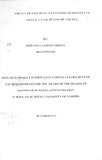| dc.description.abstract | Poverty is a pervasrve problem that is experienced throughout the world. Poverty deprives people access to proper housing, food consumption, education, health care and f ability to accumulate assets that generate income. The purpose of the study is to find out the impact that Saccos in Kisumu County have on alleviation of poverty. Saccos are financial institutions that are owned and controlled by members for the purpose of providing savings. loans, insurance and other services like welfare funds and advances to members. Kisumu County has 45 Saccos with 42,183 members spread in Kisumu East, Kisumu west, Nyando, Muhoroni and Nyakach. The Saccos provide financial services of savings and various types of loans for development, school fees and emergencies. Poverty however remains a problem in Kisumu County. The rate of poverty is still high and is estimated to be 47.8 % according to Integrated Household Budget survey. This has informed the need for the study to determine the impact that these Saccos have on alleviation of poverty.
The study will be useful to financial institutions in designing suitable products to members, government and its agencies for instituting policies and legislations that are appropriate to Sacco members. It will also be useful to members and the public for awareness of the impact of Saccos in their economic and social welfare. The population of the study will be all members of Saccos in Kisumu County. A sample of 2,100 members was selected and data was collected using questionnaires, interviews and review of existing records. Descriptive statistics will be used to analyze the data to be presented in form of tables and graphs. The findings indicate that 5% of the Sacco members fall below poverty level which is expenditure of less than ksh 100 per day. Poverty of Sacco members is more pronounced among the small traders and farmers with rates of 40 % and 34 % respectively. It also shows that among the income groups with spending of less than ksh 100, 68 % of the members have income below ksh 10,000 per month.
In conclusion, Saccos have positive impact on alleviation of poverty in Kisumu County as 95 % of the members fall above poverty level of expenditure of less than ksh 100 per day. It is notable that, however much poverty among traders and farmers may be comparatively high, it falls among a small and insignificant proportion of the Sacco members with only 5% being considered poor. The indicators of poverty including; health care, education and other issues that address reduction of poverty like small business ventures, emergencies like funerals, sicknesses and weddings are financed by Saccos. I therefore recommend that policies and regulations need to be instituted to enable members to venture into sustainable income generating ventures. The small traders, artisans and farmers who form majority of the poor Sacco members need favourable legislative and policies including; taxation, interest rates and subsidies. For those who may need research in a similar topic, they need to fine! out the impact that Saccos have on the performance of institutions that remit members contributions. | en_US |

